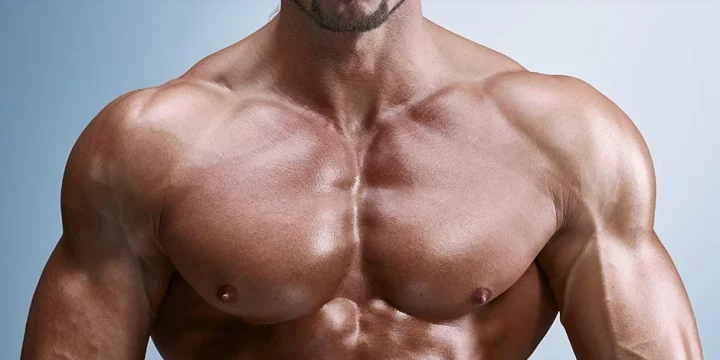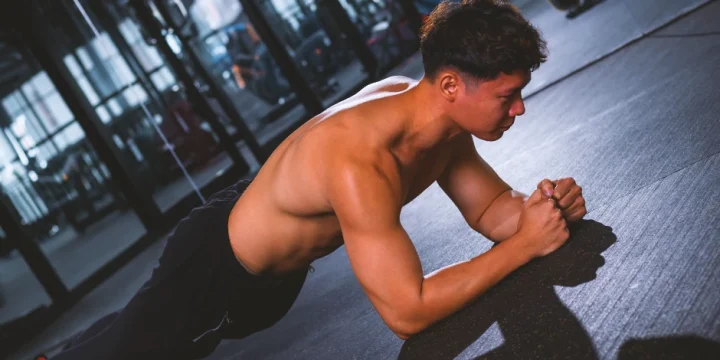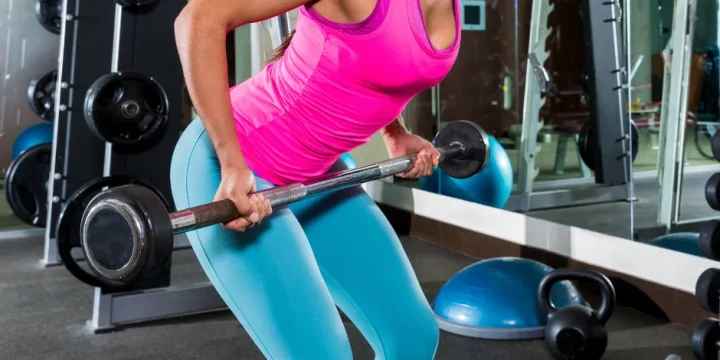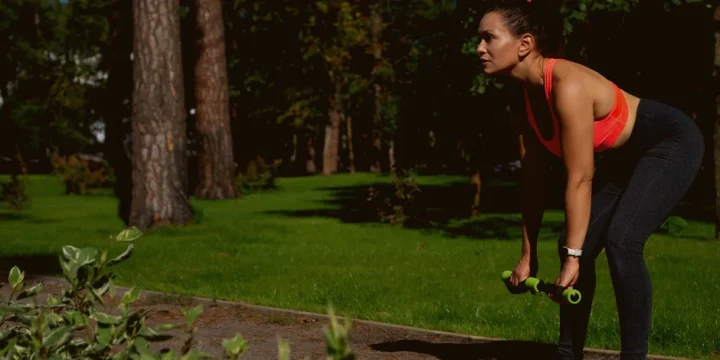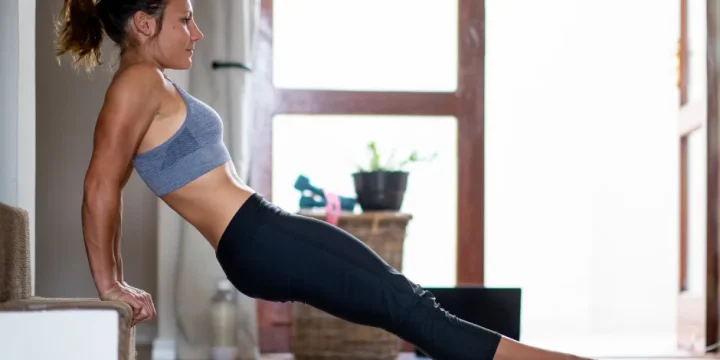Shoulder muscles are one of the largest muscles in the body, and training them will improve your shoulder health and posture, increase strength, and prevent injuries.
My team and I dedicated months of research to find the best shoulder isolation exercises for developing your desired V-shape look.
Read on to find out.
Quick Summary
- To achieve a perfect V-shape, incorporate the nine best shoulder isolation exercises, such as dumbbell lateral raises and cable rear delt flys, into your workout routine.
- These exercises target specific shoulder muscles like the middle deltoid, rear deltoids, and anterior deltoids for comprehensive development.
- A study in the Journal of Advanced Nursing highlights the effectiveness of exercises like the upright row in improving scapular stability and posture.
- In my professional experience, combining these isolation exercises with a tailored training program significantly enhances shoulder strength and aesthetics.
9 Best Shoulder Isolation Exercises

1. Dumbbell Lateral Raise
From my personal training sessions, I've found the dumbbell lateral raise to be exceptionally effective for isolating and sculpting the middle deltoid area.
How to do dumbbell lateral raises:
- Start seated with the dumbbells resting on your thighs and the palm facing inward.
- Lift the dumbbells out and away from you. Your arms must be parallel to the ground, keeping a slight bend at your elbows.
- Slowly lower the weights and, with control, make sure our core is engaged throughout the movement.
- Repeat until you reach your desired number of reps.
2. Cable Rear Delt Flys
Cable rear delt flys allow you to activate the rear deltoids along with the trapezius, the rotator cuff muscles (Infraspinatus, Teres minor, and supraspinatus), the triceps, and the rhomboids.
How to do this exercise:
- Stand facing the cable machine, feet shoulder-width apart.
- Grasp the right cable handle with your left hand and the left handle with your right hand.
- Take a backward step while keeping your core tight and your arms slightly bent at the elbows.
- Contract your rear delts to bring both arms forward slowly.
- Slowly return to the starting position while maintaining complete control of the weights.
Related: Best Infraspinatus Exercises
3. Front Incline Dumbbell Front Raise
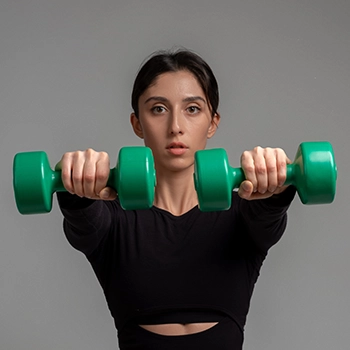
Having coached beginners and advanced clients alike, I can vouch for the front-incline dumbbell raise as a top choice for developing the anterior deltoids.
It offers a greater range of motion than standing or upright-seated raises while hitting those shoulders from an entirely different angle.
To perform the movement:
- Sit on an incline bench with your chest on the bench and your legs on the floor.
- Hold a dumbbell in each hand.
- Extend your arms straight in front of your body.
- Inhale as you lift your arms until they reach eye level.
- Exhale as you pause for one to three seconds while squeezing your shoulders.
- Inhale as you lower your arms back to the starting position.
- Repeat until you complete the recommended amount of reps.
You can also perform the same exercise in a reverse position with your back on a bench, but it’s not recommended for beginners.
4. Barbell Push Press
The barbell push press can strengthen multiple muscle groups: the deltoids, triceps, traps, and upper back.
To do this exercise:
- Place the barbell on your shoulders with an open grip and keep your feet shoulder-width apart.
- Slowly lower into a quarter squat position.
- Then, use your legs to press the barbell overhead explosively.
- Slowly lower the barbell back to the shoulders to return to the starting position.
- Repeat.
“The push press is the ultimate training tool for improving timing and power utilization in overhead movements, Olympic lifting, and general performance training.”
- Riley Stefan, Weightlifting Coach
5. Arnold Press
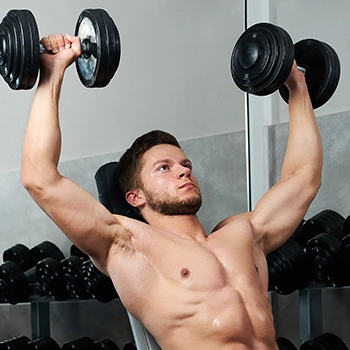
The Arnold press, named after bodybuilding icon Arnold Schwarzenegger, is a must-have exercise for gym-goers looking to increase their strength, mobility, and overall athletic performance.
It targets all three deltoid heads due to its rotational nature, which boosts hypertrophy.
To do this exercise:
- Sit down on a bench with a dumbbell in each hand held in front of you and retract your shoulder blades.
- Then, press the dumbbells straight up over your head while twisting your hands so your palms face away from you.
- Straighten your arms and hold for one to three seconds before lowering the dumbbells back down to shoulder level.
- Press the weights back up and repeat for eight to twelve reps.
6. Dumbbell Shoulder Press
The dumbbell shoulder press is an excellent choice to build strong, defined shoulders, improve posture, and prevent injuries.
It can be a great alternative to the Arnold press, as it is easier on your shoulder joints.
To do this exercise:
- Sit on a bench with your feet flat on the ground.
- Hold two dumbbells with an overhand grip at shoulder level with palms facing forward.
- Press the dumbbell overhead until your arms are fully extended.
- Lower the dumbbell to the starting position.
- Repeat until you reach your desired reps.
Also Read: Worst Shoulder Exercises
7. Seated Dumbbell Press
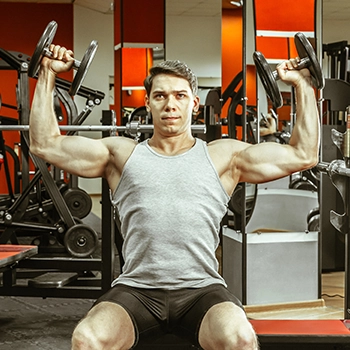
This exercise aims to strengthen the anterior, middle, and posterior deltoids.
It can also activate the biceps, triceps, and rotator cuffs to a lesser extent.
To do this exercise:
- Grab a barbell and hold it at shoulder height.
- Sit on a bench with your feet flat on the ground.
- Press the barbell above your head while keeping your midline tight throughout the movement.
- Slowly return to the starting position under control.
- Repeat until you complete your desired number of repetitions.
Related: Best Dumbbell Shoulder Exercises for Strength and Mass
8. Standing Cable Reverse Fly
Incorporate the standing cable reverse fly exercise into your cable shoulder workouts if you want to target the posterior deltoids.
To perform this exercise:
- Place the cable machine at shoulder height, stand with the feet shoulder-width apart, and grip each handle facing away from each other.
- Grab a stirrup cable attachment in each hand with a neutral grip and extend your arms as far behind your torso as possible to squeeze the shoulder blades in the end position.
- Pause while squeezing your posterior delts at the contraction point.
9. Upright Row
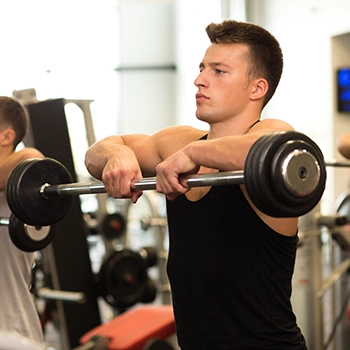
According to the Journal of Advanced Nursing study, the upright row targets the deltoids and the traps, which can help you improve scapular stability and posture [1].
See also this guide on how to do cable upright row.
To do this exercise:
- Hold a barbell in front of your thigh and stand with your feet shoulder-width apart.
- Lift the barbell vertically until your upper arms are parallel to the floor.
- Pause at the top before lowering the barbell back down, and repeat.
Related: Recommended Upright Row Alternatives
How to Program Shoulder Training?
In my approach to shoulder training, I emphasize tailoring the program to each client's specific fitness goals, workout intensity, and training frequency.
- Fitness goal - Use heavy weights with low reps to improve your strength. With hypertrophy, try increasing your reps and using lighter weights.
- Frequency - Drawing from our experience, training your shoulders at least twice weekly with at least one recovery day between sessions is best. Also, start your shoulder training with compound exercises and switch to isolation exercises to target specific muscle groups and provide the metabolic energy required for hypertrophy.
- Intensity - A male lifter's standard dumbbell shoulder press weight is 32 kg (1RM). If you prioritize strength over endurance, include kettlebells and resistance bands in your shoulder workouts.
For optimal muscle growth, you should include a high-protein diet or include one of the protein powders below:
What Are the Benefits of Shoulder Isolation Exercises?

From my professional perspective, shoulder isolation exercises not only enhance physical appearance and strength but also play a key role in injury prevention and muscle mass development.
- Improved muscle definition - Focusing on one muscle at a time helps target hard-to-train muscles like rear delts, maximizes growth potential, and gives sculpted results.
- Build muscle mass - The shoulder isolation exercises listed above will help you target all your shoulder muscles for maximum growth.
- Enhanced physical appearance - Training your shoulders will give you that V-shape; this is especially important for bodybuilders.
- Reduced chances of injury - Unlike heavier compound movements, isolation exercises can be a great way to gain strength and stability with fewer chances of injury, as per the research in the North American Journal of Sports and Physical Therapy [2]. To target the rear delts and improve rotator cuff health, I strongly recommend face pulls.
Focusing on isolated movement patterns builds a strong foundation for other, more complex weight-training routines.
By practicing smoother ball-and-socket movement, shoulder isolation exercises reduce injury risks, promote better posture, and optimize performance in everyday tasks.
- Taylor Kuhlmann, Licensed Physical Therapist & Certified Strength & Conditioning Specialist
Related Articles:
FAQs
What Shoulder Exercise is Most Effective?
The most effective shoulder exercise is the shoulder press. It involves activating your shoulder joint to press an object, such as a dumbbell, away from the body. This strengthens the shoulder muscles and recruits other upper arm muscles as you move the weight around.
What Shoulder Exercises Hit the Heads of the deltoids?
Shoulder exercises that hit the head of the deltoids are the overhead barbell press, seated lateral raise, Arnold press, front raise, and barbell shrug.
What Are the Muscles in the Shoulders Called?
The muscles in the shoulders are called the trapezius, latissimus dorsi, levator scapulae, rhomboids, deltoids, teres major, and rotator cuff.
References:
- https://pubmed.ncbi.nlm.nih.gov/33009847/
- https://www.ncbi.nlm.nih.gov/pmc/articles/PMC2953337/
About The Author
You May Also Like
